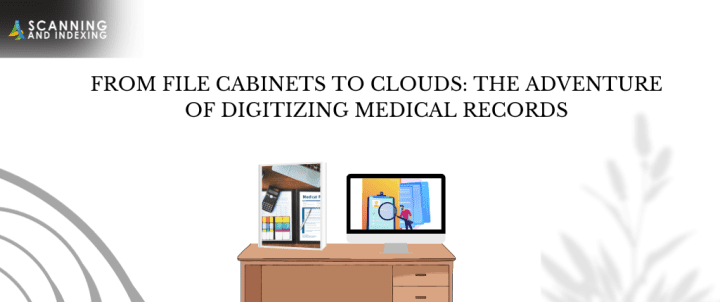From File Cabinets to Clouds: The Adventure of Digitizing Medical Records
Importance of Digitizing medical records
Digitizing or digitization refers to the transformation of paper documents into digital format.
Businesses keep on evolving with technological advancements happening in our daily lives. Paper documents and dusty file cabinets are one of the main evidence of changing offices. It’s very hard to spot manual records and documents in office cabins now. With Medical Record Documentation and database management, organizations can accelerate business operations significantly.
Health sectors and medical professionals play a vital role that has a great place in individual life, communities, and society in many aspects. Healthcare organizations, including hospitals, clinics, and wellness centers, experience high levels of crowding. In addition, Healthcare organizations have to deal with plenty of calls, queries, and appointments daily. Thus, lots and lots of data have to be processed every single day to organize daily tasks.
For example, when a person is ill, he or she has to call and book an appointment with the doctor. Therefore, the organization has to collect patient data such as address, age, and date to schedule the appointment. The hospital side must process, store, and share numerous datasets related to diagnosis and vitals.
These datasets are very important and of high value. So, it’s hard to manage this kind of critical information on paper and sheets. It’s a great deal of stress and work to manage these papers, documents, or records as they are very prone to damage or permanent loss.
Challenges in traditional record-keeping
Ø Storage and Space Constraints
As we told earlier, medical records and documents have high value. These documents require attention, space, and expense. Healthcare organizations accumulate tonnes of paper documents every year, and a full room is not enough. Over time, these documents become bundles of mountains within no time. Life-saving documents and records stuffed up in tight spaces are very difficult to find, edit, or retrieve in case of emergency situations. Moreover, these documents are prone to permanent loss and damage in case of natural disasters, accidents, and other unforeseen incidents.
Ø Lack of Data Analytics and Insights
Paper documents and records limit the ability to derive insights and patterns for accurate decision-making. Manually handling paper records and files is a tedious task. Because both the doctors and patient have to go through brainstorming sessions or memorize a lot when you go through dozens of paper sheets. It’s a headache shifting your paper from one clinic to another if your doctor says so. Thus, analyzing paper records to find patterns is almost impossible and is a waste of time.
Ø Data Security and Privacy
Traditional database management has many risk factors, and they are vulnerable to thefts, breaches, and privacy. Medical records are considered high-value documents that have a lot of confidential elements such as illness, address, and other elements. Without your consent, individuals can easily duplicate and exploit paper documents. Moreover, you cannot protect these documents at all times or put up robust safety measures such as advanced firewalls, software, and certifications.
How is digitization done for medical records?
The digitization process of hospital records varies with the healthcare organization. Anyway, here is a general outline of the medical record digitization process step by step.
- Document Preparation: This is the first step of the digitization process. In this stage, the paper documents are collected and prepared for digitization. This process involves sorting the files on criteria such as alphabetical, chronological, or other aspects. Healthcare professionals use staples, pins, stickers, and threads to allocate the papers correctly.in addition, Document preparation involves removing these things that can hinder the next process.
- Scanning: After preparation, the documents will undergo scanning. These procedures make use of advanced software and scanning devices that can capture images of the paper document in high-quality visuals. So, this advanced technology and scanning devices make sure that a simple coma or quotation is valued and digitized accurately. Digitizing medical records through scanning involves intricate and time-consuming scanning procedures. These processes can be carried out either in-house or outsourced to Expert Medical Record Scanning Services.
- Indexing: Document indexing refers to the process of sorting and assigning metadata to simplify the search and find process. People with illness have to make appointments with doctors for reviews and to know about recovery. To ensure convenient reference to patient information, it is crucial to have easy access to files and documents. Indexing promotes digitization, and after indexing patient records, both the person and management can search, find, and sort any file in the future. After scanning, the digital files need to be indexed and assigned relevant metadata for easy retrieval.
- Quality Checks: Quality checks are the vital element that ensures the accuracy of digitized documents. They make sure that the records are error-free and true. In this phase, each and every document is reviewed and crosschecked to locate errors such as scanning errors, missing pages, figure errors, or text errors. Quality checks can spot incomplete and repetitive content and flag them to correct.
- Storage Management: This is one of the crucial stages of digitizing medical records. After strong quality checks, these documents have to be stored in EHR (electronic health record) systems. Once you store these records in EHR or Electronic Document Management Systems, you can easily find, edit, store, and share documents with a few clicks of your fingers.
- Data Migration and Integration: After successfully digitizing records and documents, there is a need to actively perform file transfers and migrations, even though they are already in a digital format. Certain databases may have already undergone digitization and are saved in digital formats. Therefore, these have to be sorted and arranged seamlessly into the new digital environment. Data migration allows existing systems and records to collaborate successfully with the newly formed one.
- Adoption programs: In the digitization process of medical records in healthcare sections, training and conducting sessions are considered the final phase. When introducing a new digital system into the workplace, we provide training and induction sessions to all healthcare professionals and staff members. Thus, they can know and practice activities such as searching, retrieving, sharing, and updating records all by themselves.
Best practices for successful digitization
Here are some of the key practices that ensure digitization is on point.
- Data Accuracy and Integrity
Accurate data management is a crucial factor that determines the success of the digitization of an organization. Implementing some practices enables organizations to maintain a structured workflow throughout the process.
- Standardized naming practices
When a group of people works on a digital file, it can create confusion and complications for the next guy who is about to work on the file. Digitized files are very easy to edit, share, and save. It is common for people to unintentionally overlook reporting changes or accidentally delete files. These small errors cause misunderstandings that lead to extra costs. Thus, establishing accurate naming conventions and consistent naming practices that foster file collaboration.
- Data backup procedures
Regular data backup procedures ensure the safety of digital assets in a workplace. Regular review and data backup protocols ensure data redundancy of digital files. Moreover, by implementing regular backup protocols in a workplace, you’re putting up robust safety measures and getting to know new systems such as Cloud computing and NAS devices.
- Audits and security checks
Frequent monitoring and checking for anomalies is a cool way to prevent your data from fraudulent activities. Try to implement data protection regulations and protocols that implement safety measures that address and flag unusual activities at the earliest. In addition, Regular audits and reviews improve quality concerns throughout the organization.
Bottomline
The journey from dusty file racks to clouds is truly inspiring. The digitization of medical records has brought significant changes to healthcare organizations. Digitization of records has paved the way to an improved workflow, collaboration, and access to important data whenever needed. As healthcare organizations continue to adapt to digital solutions, we can see significant improvements and decision-making capabilities to provide quality patient care. If you’re looking for the best document scanning service providers in India, you’re in the right place. Reach us via mail at [email protected].






